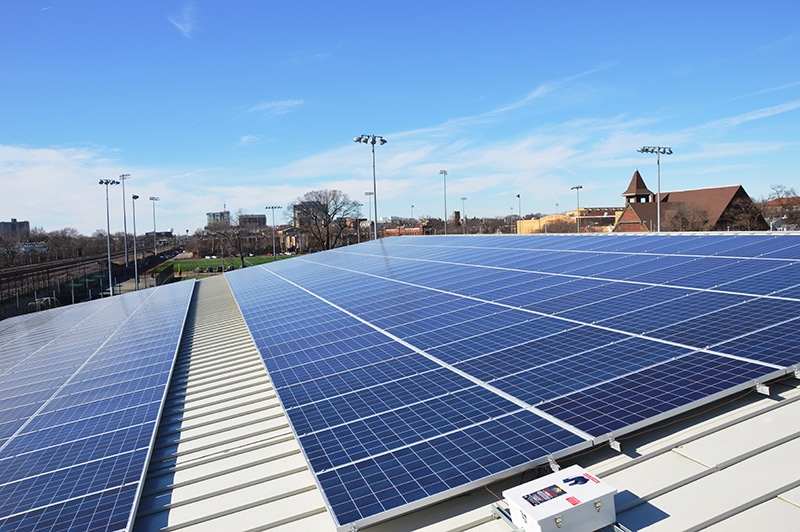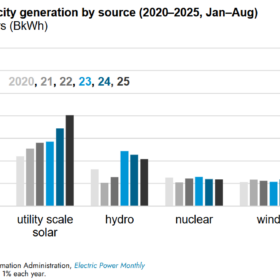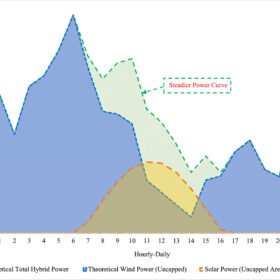As Illinois’ solar programs activate and expand, an incentive for “smart” inverters may be a window into the implications of widespread deployment and compensation of PV. ComEd and Ameren Illinois are offering rebates of $250/kW for smart inverters for PV systems for nonresidential Rate DS-3 customers, defined as 100 kW electric capacity in ComEd’s service territory and 150 kW in Ameren Illinois’. The size limit is 2 MW for both distributive generation and community solar installations.
Smart inverters are a major improvement from previous technology in three ways. They are more active in voltage, frequency and other electrical functions, and capable of being more participatory in grid management. Smart inverters can also receive commands from and supply information to grid operations. Lastly, smart inverters combined with smart meters can operate in a de facto dual phase metering role, separating the electrical flow generated by the PV system and the demand of electricity from the grid to the customer.
Traditional inverters operating off a meter would function in a bi-directional fashion, netting out the difference between PV outflow and grid inflow. Before smart inverters, two meters would operate in a dual channel capacity, separating the two flows. This was a practice in countries like Germany, where PV power on buildings went out into the grid on one channel, and the building’s electricity came in through another. This was advantageous to the building/system owner, who was compensated for years at a higher tariff for the PV electricity generated than was paid for consumption, in order to grow the market.
The smart inverter incentives, at $0.25/watt is a significant amount for larger systems and can help to insulate installation costs from the Section 201 tariff and other price pressures. But the introduction by the utilities of these incentives will raise a number of technical, economic and policy issues in the Illinois market going forward. The use of smart inverters can be considered a necessity to enable the PV market to grow and help support a stable grid. Policies like California’s “Rule 21” and Hawaiian regulations now require smart inverters in all installations. A number of utilities are also running pilot programs for smart inverters.
Technically, conditions like voltage and frequency “ride throughs” can be better managed and real or reactive power can be better controlled with smart inverters; previous technology would have PV systems drop out of production if parameters were exceeded. Power interruptions can also be reduced with smart inverters as control mechanisms can allow for staged, “soft start” power generation from PV systems as the grid is restored to service.
Business and policy issues may become magnified with smart inverters, particularly as PV is equipped with energy storage, microgrids and other applications. At present, the volume of installed solar in Illinois is minuscule at less than 0.1% of peak capacity in the state. But that percentage will climb as rooftop and utility scale installations grew rapidly due to the Future Energy Jobs Act taking effect in June, 2017.
Other markets, like community solar and the low-moderate income Illinois Solar For All, are already in a pipeline as regulatory approval has been made, and final administrative systems are established. The ComEd service territory alone has hundreds of interconnection applications for community solar totaling hundreds of MW of capacity. Many of these applications are planning energizing in mid-2019.
This can place Illinois in a gigawatt-sized market within a few years for the distributed solar market alone. One of the metrics ahead for Illinois PV is a 5% capacity threshold, which can result in a change of compensation rates for PV systems installed afterwards. This capacity threshold would be reached if distributed PV reaches about 1,200 MW of ComEd’s estimated 24,000 MW, and around 430 MW of Ameren Illinois’ estimated 8,600 MW.
PV systems with smart inverters in Illinois would be considered “virtual regulatory assets”, where utilities could claim a rate of return. Net meter rates could be changed where compensation may only at a lower avoided cost, rather than retail, rate. This may bring about some version of a “Value of Solar Tariff” that would address the value of solar power and reflect market forces.
Another issues is that smart inverters could mean potential curtailment of output by utilities if that power is not wanted. This would bring to the forefont the role of energy storage systems, and encourage regulators to determine a tariff role. This would be in addition to the advantage energy storage could have for reducing demand charges behind the meter.
This content is protected by copyright and may not be reused. If you want to cooperate with us and would like to reuse some of our content, please contact: editors@pv-magazine.com.








You are aware that a “smart meter” and “smart inverter” are two different pieces of hardware and do totally different things. The smart meter measures the energy consumption or the energy put back onto the grid at the site. The smart inverter converts and controls the energy output from the PV or generation systems.
Yes, all of our writers are familiar with both pieces of hardware. Is there a technical point here, or line in this article that you think confuses one for the other?
I re-read it again and was confused about title saying of “rebates for smart meters” and then only discussing “rebates for smart inverters”.
“ComEd and Ameren Illinois are offering rebates of $250/kW for smart inverters for PV systems for nonresidential Rate DS-3 customers, defined as 100 kW electric capacity in ComEd’s service territory and 150 kW in Ameren Illinois’. ”
The rebates are for smart inverters and not smart meters. I was confused by the title and section above. I will need to read DS-3 to get more insight but I’ve never heard of a rebate for smart meters.
Thanks,
Thanks for alerting me to that. It was probably a typo that slipped our editing process, and has been changed.
You’re welcome.
NES smart meters meet the future market and regulatory needs of a utility by incorporating a rich set of features including prepay, multi-tariff abilities, remote firmware updates, remote connect and reconnect, tamper and outage detection, hardware extensibility, direct relay control, software-configurable service levels, and load factor monitoring. I do recommend NES website: https://www.networkedenergy.com/en/products/smart-meters for you to check, it’s really useful..
How does one actually apply to this rebate? Does anyone have any information about how to claim the rebate for eligible systems? Thanks in advance.